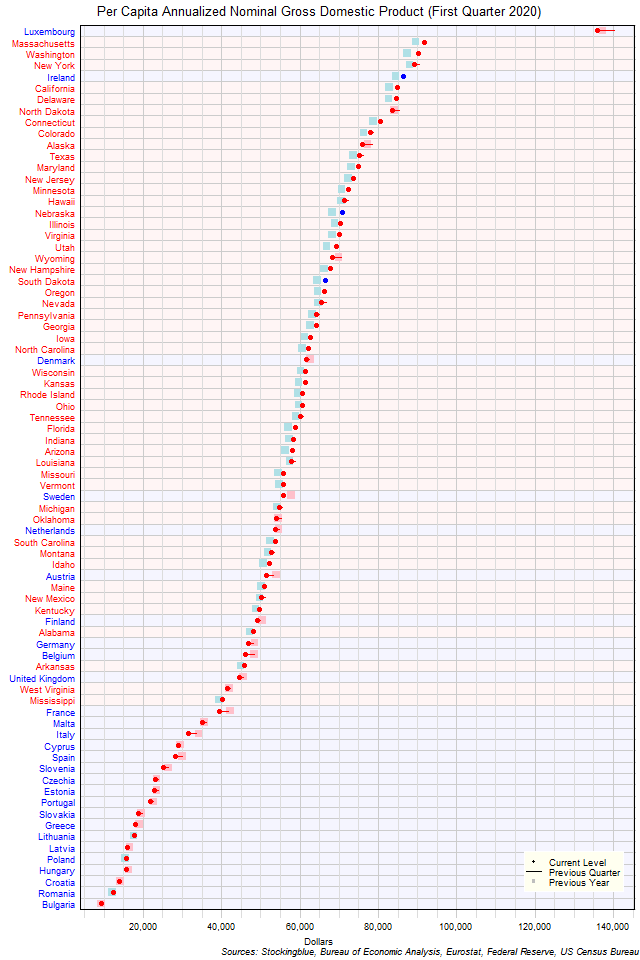
The chart above shows the per capita annualized nominal gross domestic product (GDP) in each EU and US state as of the first quarter of 2020 in dollars, the change from the previous quarter, and the GDP one year prior. Luxembourg is in a class all by itself.
Findings
- The difference between the state with the largest per capita GDP, Luxembourg, and the state with the smallest, Bulgaria, is $126,776.71 (down from $130,930.31 last quarter and down from $128,034.90 last year). Luxembourg and Bulgaria had the largest and smallest per capita GDP respectively both last quarter and last year.
- Luxembourg has 14.70 times the per capita GDP that Bulgaria does. The ratio of largest per capita GDP to smallest per capita GDP was down from 15.08 last quarter and down from 14.78 last year.
- The median per capita GDP in the 28 EU states is $28,580.55 (down from $29,578.72 last quarter and down from $29,780.09 last year) and the mean $36,606.63 (down from $37,605.77 the previous quarter and down from $37,575.03 last year).
- The median per capita GDP in the 50 US states is $63,437.49 (down from $63,724.57 last quarter and up from $61,971.46 last year) and the mean $64,738.96 (down from $65,385.74 the previous quarter and up from $63,584.66 last year).
- The median per capita GDP in the 78 EU and US states is $56,855.22 (down from $57,323.00 last quarter and up from $56,675.18 last year) and the mean $54,640.17 (down from $55,413.44 the previous quarter and up from $54,247.87 last year).
- Three states (1 EU, 2 US) saw their per capita GDP rise in current dollars from the previous quarter while 75 saw their per capita GDP drop (27 EU, 48 US).
- Forty-nine states (4 EU, 45 US) saw their per capita GDP rise in current dollars from last year while 29 saw it drop (24 EU, 5 US).
- Some EU drops in GDP are attributed to currency rate fluctuations.
Caveats
- GDP data is from the first quarter of 2019, the fourth quarter of 2019, and the first quarter of 2020.
- US census data is from 2010, EU census data is from 2011.
- The data is seasonally adjusted in current dollars.
- Euros are converted to dollars at an average exchange rate of 1.14 for the first quarter of 2019, 1.11 for the fourth quarter of 2019, and 1.10 for the first quarter of 2020 according to historic rates listed at the Federal Reserve (see source link below).
- US data comes in an annualized format which the EU does not, thus EU data is annualized by multiplying the quarterly figure by four.
- US growth rates may differ from those provided by the Bureau of Economic Analysis as the BEA's growth rates are based on chained dollars in conjunction with the chain index or the quality index for real GDP. The growth rates listed here are based on nominal GDP.
- All figures are rounded to the nearest hundredth.
Details
In absolute terms, Luxembourg had the worst performance over the previous quarter with a drop of $4,193.82. Ireland had the best performance with a gain of $502.32. Year over year, France had the worst performance with a drop of $2,735.12 while Washington had the best performance with a gain of $2,849.47.
In relative terms, Italy had the worst performance over the previous quarter with a 6.01% drop in per capita GDP while Ireland had the best performance with a 0.58% rise in per capita GDP. Year over year, Italy had the worst performance with a 7.96% drop in per capita GDP while Utah had the best performance with a 3.60% rise in per capita GDP.
The number of states with a per capita GDP of over $75,000 was 11 last year, 13 the previous quarter, and 12 this past quarter. Conversely, the number of states with a per capita GDP of less than $50,000 was 27 last year, 26 the previous quarter, and 27 this past quarter.
South Dakota (from 25th largest per capita GDP to 23rd largest) surpassed two states over the previous quarter. Wyoming (from 19th to 21st), Nevada (from 23rd to 25th), and Louisiana (from 37th to 39th) each was surpassed by two states. Year over year, Florida (from 39th to 36th) and Missouri (from 43rd to 40th) each bested three states. On the flip side, Sweden (36th to 42nd) was bested by six states.
No EU states overcame any US states over the previous quarter and no EU states overcame any US states over the same quarter last year. Meanwhile, two US states surpassed two EU states over the previous quarter and 21 US states surpassed nine EU states over the same quarter last year. This disparity is partially due to the rise of the dollar against the euro over the course of the past year.
Sources
Eurostat. 2017. "Population on 1 January by Age Groups and Sex - Functional Urban Areas." Accessed December 11, 2017. http://appsso.eurostat.ec.europa.eu/nui/show.do?dataset=urb_lpop1&lang=en.
Federal Reserve. 2020. "Foreign Exchange Rates." Accessed July 16, 2020. https://www.federalreserve.gov/releases/g5/.
US Bureau of Economic Analysis. 2020. "GDP by State." Accessed July 14, 2020. https://www.bea.gov/data/gdp/gdp-state.
United States Census Bureau. September 2012. "United States Summary: 2010: Population and Housing Unit Counts." Accessed January 23, 2018. https://www.census.gov/prod/cen2010/cph-2-1.pdf.